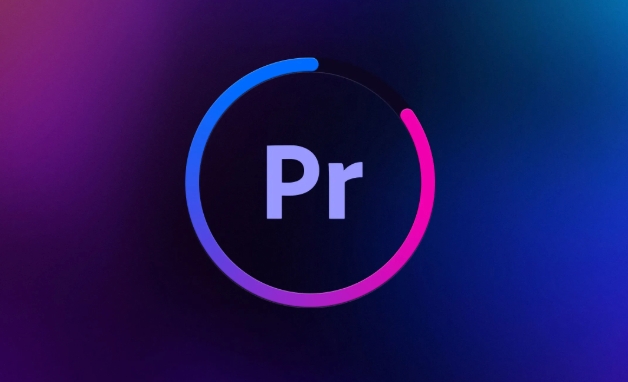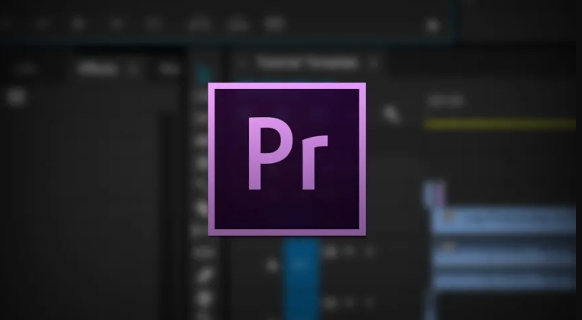how to remove background noise in Premiere Pro
Jul 12, 2025 am 12:14 AMNoise reduction using Premiere Pro can be achieved in three steps: first, use the "Basic Sound" panel to select the "Dialogue" type and enable the "Noise Reduction" function to quickly clean the ambient sound; second, for complex noise such as wind sound, you need to manually collect noise samples and add the "Noise Cancellation" effect. It is recommended to set the noise reduction level to 60%-80%; finally, if there is multi-track audio, you can combine "Noise Gate" and EQ processing to set the threshold to mute the low volume noise and reduce low frequency interference, so that the overall sound effect is clearer and more natural.

It is actually not difficult to remove background noise, but many people feel a little confused when using Premiere Pro to process audio for the first time. In fact, in just a few steps, the sound quality can be significantly improved, especially for videos that are mainly vocal.

Quickly reduce noise with the "Basic Sound" panel
The "basic sound" panel that comes with Premiere Pro is enough to deal with most background noise issues, especially suitable for people who edit Vlogs and interview videos.

The operation method is very simple:
- Click on the audio clip on the timeline
- Switch to Window > Basic Sound
- Select the "Dialogue" type on the right, and the system will automatically optimize the voice of the people
- Scroll to the bottom to find the "Noise Reduction" option and turn on
Behind this function is actually the AI ??model trained by Adobe analyzed a large number of voice samples, so the recognition accuracy is quite high. If you just want to quickly clean up the ambient sound (such as the sound of a fan in the office), this trick is enough.

Manual sampling for accurate noise reduction
For more complex situations, such as continuous wind sounds or air conditioning sounds when outdoor shooting, it is necessary to use the "noise cancellation" effect and sampling to deal with it.
The steps are as follows:
- Find a clip with only background noise and no human voice (usually you can find it at the beginning or end of the video)
- Right-click this audio > "Collection of Noise Samples"
- Go back to the audio clip you want to process
- Add "Noise Reduction" effect (Search "Noise Reduction" in the effects panel)
- Adjust the "Noise Reduction Level" slider, it is recommended to start listening from 50%, and then gradually increase it.
There is a detail here that is easy to ignore: Don’t adjust the noise reduction to 100% at one time, as it will make the sound dull, as if you are talking through something. Generally, 60%-80% is already very clean, and it can also retain the natural feeling of human voice.
Combined with multi-track processing to improve overall clarity
If you have multiple audio tracks in your project (such as main microphone ambient radio), you can use a combination of "noise gate" and EQ to further optimize.
For example:
- The main microphone is loud and has good quality, and can be processed with "basic sound" and "noise cancellation"
- The ambient track is only used as background atmosphere. You can add a "noise gate" to set a threshold to automatically mute the sound below this volume.
- Then, through simple EQ, cut off the low-frequency rumble a little (for example, attenuation of 3-6dB below 85Hz)
After this processing, the entire audio level will be clearer and the background noise will not easily interfere with the audience's attention.
Basically these common methods are. Not every time, you have to go all out. Choose one or two according to the actual situation. The key is not to be too ruthless, leave some sense of space, so that it will sound natural.
The above is the detailed content of how to remove background noise in Premiere Pro. For more information, please follow other related articles on the PHP Chinese website!

Hot AI Tools

Undress AI Tool
Undress images for free

Undresser.AI Undress
AI-powered app for creating realistic nude photos

AI Clothes Remover
Online AI tool for removing clothes from photos.

Clothoff.io
AI clothes remover

Video Face Swap
Swap faces in any video effortlessly with our completely free AI face swap tool!

Hot Article

Hot Tools

Notepad++7.3.1
Easy-to-use and free code editor

SublimeText3 Chinese version
Chinese version, very easy to use

Zend Studio 13.0.1
Powerful PHP integrated development environment

Dreamweaver CS6
Visual web development tools

SublimeText3 Mac version
God-level code editing software (SublimeText3)

Hot Topics
 how to use the razor tool in Premiere Pro
Jul 02, 2025 pm 03:58 PM
how to use the razor tool in Premiere Pro
Jul 02, 2025 pm 03:58 PM
The method to quickly use the razor tool in PremierePro is to press the C key; 1. Press the C key on the keyboard to switch to the razor tool, or you can find the knife icon in the left toolbar to select it; 2. Position the playback head to the position you need to cut, click the clip to cut; 3. If you need to delete the middle part, you can select the middle section and press Delete to delete it after the same clip is cut again; 4. Use the selection tool (V) to adjust the sequence of the clips or leave a blank timeline; 5. If you need to cut the multi-track clip at the same time, you can check "All tracks" in the top menu; 6. If you accidentally cut the wrong clips, you can undo or right-click the clips; 7. In addition, press and hold the Alt left mouse button to temporarily enable the razor function without switching the tool; pay attention to ensuring that the playback head is used when using it; 6. If you accidentally cut it wrong, you can undo or right-click the clips; 7. In addition, press and hold the left mouse button of the Alt mouse to temporarily enable the razor function without switching the tool;
 how to fix audio drift in Premiere Pro
Jul 02, 2025 pm 04:01 PM
how to fix audio drift in Premiere Pro
Jul 02, 2025 pm 04:01 PM
To solve the problem of audio and video out of synchronization in PremierePro, first check the timeline settings to ensure that the frame rate matches the audio sample rate; secondly enable hardware acceleration and optimize cache settings to improve performance; then use the synchronization lock function to prevent mismoving the track; finally pay attention to exporting settings, select a stable format and confirm that the audio parameters are correct. Perform the above steps in turn to effectively avoid audio and video drift problems.
 how to fade audio in Premiere Pro
Jul 05, 2025 am 12:50 AM
how to fade audio in Premiere Pro
Jul 05, 2025 am 12:50 AM
Adding a fade effect to audio in PremierePro can be achieved in three ways: 1. Use audio transition effects such as "Constant Gain" or "Exponential Fade" and drag directly to the beginning of the audio clip; 2. Manually add volume keyframes in the "Effect Controls" panel, and control fade speed and nature by adjusting the keyframe position and curve; 3. Use the "Trail Mixer" to drag the volume slider in real time to record the operation track, which is suitable for unified management of multi-track audio. Each method has its own advantages. Newbie can choose to quickly achieve the transition effect, advanced users are suitable for manual adjustment or use the track mixer to obtain more refined control. Finally, it is recommended that preview ensures that the audio transition is natural and smooth.
 how to apply an effect to multiple clips in Premiere Pro
Jul 05, 2025 am 12:22 AM
how to apply an effect to multiple clips in Premiere Pro
Jul 05, 2025 am 12:22 AM
There are three ways to quickly add the same effect to multiple clips in PremierePro: 1. Use the "EffectChainer" tool to first apply the effect to one clip, and then click other clips one by one through the chain icon in the effect panel to apply it in batches; 2. By copying and pasting attributes, right-click the first clip with added effects in the timeline to select copy, then select other clips to right-click to select paste attributes, and only select video or audio effects to paste; 3. Use the adjustment layer to process the video effect, create a new adjustment layer and place it above the target clip, and drag the effect to the adjustment layer to affect all clips below it. The above methods can significantly improve work efficiency and are suitable for the needs of different scenarios.
 how to normalize audio in Premiere Pro
Jul 04, 2025 am 12:16 AM
how to normalize audio in Premiere Pro
Jul 04, 2025 am 12:16 AM
NormalizingaudioinPremiereProadjuststheloudestpeakinacliptoatargetlevel,balancingvolumeacrossclips.1.Right-clickaclipandchoose“AudioGain…”2.Select“NormalizeMaxPeakto”andsetatargetlike-1dBor-3dB.3.ClickOKtoapply;thisscaleseachclip’svolumeuniformly.Itw
 is Adobe Premiere Pro free
Jul 03, 2025 am 12:26 AM
is Adobe Premiere Pro free
Jul 03, 2025 am 12:26 AM
AdobePremierePro is not a free software. You need to subscribe to AdobeCreativeCloud. The main methods include monthly or annual subscriptions, and students and teachers can enjoy discounts; in addition, you can also choose free alternative software such as DaVinciResolve, Shotcut, OpenShot and Lightworks; you need to pay attention to the 7-day trial period, the possible deduction of credit card binding, and the cancellation in the middle will not retain the remaining time.
 how to rotate video in Premiere Pro
Jul 04, 2025 am 01:33 AM
how to rotate video in Premiere Pro
Jul 04, 2025 am 01:33 AM
There are three ways to rotate videos in PremierePro. 1. Use the "Motion" option in the "Effect Control" to accurately adjust the rotation angle, which is suitable for fine operation; 2. Use the "Create Sequence from Clip" function to automatically correct the vertical video direction of the mobile phone, saving time and effort; 3. Use "Crop" and "Zoom" to adjust the screen to fill the screen and avoid black edges to ensure complete output quality.
 how to make text appear one letter at a time in Premiere Pro
Jul 08, 2025 am 12:02 AM
how to make text appear one letter at a time in Premiere Pro
Jul 08, 2025 am 12:02 AM
To display text letter by letter, use PremierePro’s built-in “Typewriter” animation preset or manually adjust the opacity or zoom of each character. 1. Use presets such as "Typewriter-Reveal" in the "EssentialGraphics" panel to directly apply the verbatim effect; 2. Enable character-by-character animation through the "EssentialGraphics panel" and select Opacity or Scale for customization; 3. Set Start and EndOffset to control the animation rhythm and combine keyframes to achieve dynamic changes; 4. You can adjust the offset, add blur or color change to enhance the effect. It is recommended that each letter lasts 0.1-0.2 seconds and is suitable for phrases rather than long paragraphs.






